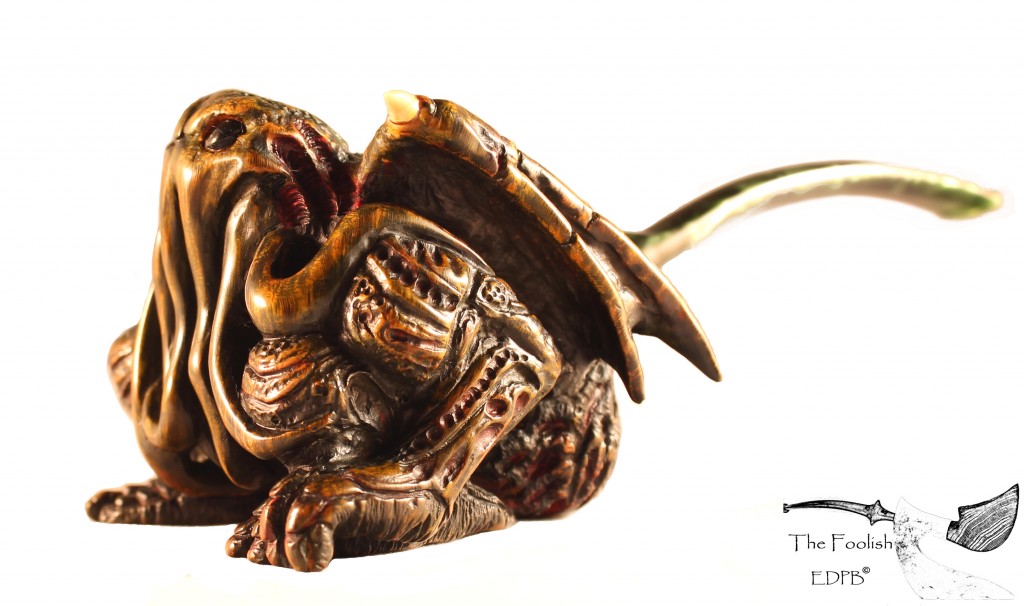You can learn a lot about someone by looking at his pipe of choice. An old, beaten up corncob gives off a very different vibe than a flawless, recently polished, Danish freehand. I am not asserting that one is better than another, but it is telling.
With that in mind, I pose a question to you: What does this pipe tell you about a person?
Quirky? Geeky? Possibly insane? I think all of these are probably accurate assessments, since I have recently been fortunate to acquire this monstrous beauty.
 Stephen Downie, hailing from Canada, is an incredibly talented pipe carver and artist; not only that, but, fortunately for me, he is also a geek. When I first stumbled across Stephen’s website, the pipe of his that caught my eye was the Balrog from Lord of the Rings. This pipe was not just a decent imitation of the fiery beast, but a fantastical representation, complete with vertebrae and horns. In addition, I saw his rendition of a Greenman, a zombie, and a king. These pipes are all pieces of art, but Stephen does not simply limit himself to “Creatures of Smoke” as he calls them, but also does the more classic designs with grace.
Stephen Downie, hailing from Canada, is an incredibly talented pipe carver and artist; not only that, but, fortunately for me, he is also a geek. When I first stumbled across Stephen’s website, the pipe of his that caught my eye was the Balrog from Lord of the Rings. This pipe was not just a decent imitation of the fiery beast, but a fantastical representation, complete with vertebrae and horns. In addition, I saw his rendition of a Greenman, a zombie, and a king. These pipes are all pieces of art, but Stephen does not simply limit himself to “Creatures of Smoke” as he calls them, but also does the more classic designs with grace.
Due to his talent and inclination towards the geeky and macabre, not to mention his being an all-around great guy, he was a natural choice for my desire to have a pipe based off of Cthulhu, the famous Great Old One invented by H. P. Lovecraft in the late 1920s. He is said to be waiting in the sunken city of R’lyeh, and might be emerging very soon. Thanks to Stephen Downie, he appeared a little earlier than was prophesied.
I have an obsession with Cthulhu, as my lady can testify: I have posters, backgrounds for my computer, many books, including a leather-bound Necronomicon, and now a pipe. She has asked quite often why this obsession exists, and there are frankly many reasons.
First off, the story is very well written, but that is not the primary reason.
Cthulhu and the entire mythos surrounding him, in my mind, capture all of what is good about horror. Cthulhu is beyond our comprehension, a thing of such greatness that we are dwarfed by the very concept of it. So far beyond our comprehension is Cthulhu that the very sight of him will cause us to go insane. This is horror in its most perfect form – it is not the ghost or monster who jumps out and yells, “Boo!”, causing you to jump a little. This is cheap horror that I label as “American Horror”, which I juxtapose with “Japanese Horror”.
In “Japanese Horror”, a Lovecraftian horror, evil simply is. American horror has a desire to explain evil: it has a source, and that source has an inspiration. Think of the most well-known American horror movies: Michael Myers from the “Halloween” movies, Jason from “Friday the 13th”, Freddy Krueger from “Nightmare on Elm Street”, along with all of the mass-murderer movies. All of the evil that occurs in these movies has a defined, understandable source; there is always a bad guy who can be caught, killed, stopped, or otherwise dealt with.
For the most part, this is not the case in Japanese / Lovecraftian horror. Evil is simply a fact of nature and we are merely caught in its path. Another one of the aspects that makes this horror successful is that it emphasizes the smallness of Man. Humans are often not targeted by the wrath of the evilness, but are simply in its path, like an anthill in the path of a toddler. The child did not intend to destroy the anthill, but the ants can do nothing against a force so much larger and beyond its understanding.
There is a scene in my favorite science-fiction TV show, Babylon 5, that sums this up perfectly. One of the characters, Catherine Sakai, encountered something while exploring a planet, Sigma 957. She asks an ambassador from another race, named G’kar, what it was:
“Catherine Sakai: Ambassador! While I was out there, I saw something. What was it?
G’Kar: [points to a flower with a bug crawling on it] What is this?
Catherine Sakai: An ant. So much gets shipped up from Earth on commercial transports it’s hard to keep them out.
G’Kar: Yes, I have just picked it up on the tip of my glove. If I put it down again, and it asks another ant, “what was that?”, [laughs] how would it explain? There are things in the universe billions of years older than either of our races. They’re vast, timeless, and if they’re aware of us at all, it is as little more than ants, and we have as much chance of communicating with them as an ant has with us. We know, we’ve tried, and we’ve learned that we can either stay out from underfoot or be stepped on.
Catherine Sakai: That’s it? That’s all you know?
G’Kar: Yes, they are a mystery. And I am both terrified and reassured to know that there are still wonders in the universe, that we have not yet explained everything. Whatever they are, Miss Sakai, they walk near Sigma 957, and they must walk there alone.”
That is the true and perfect terror: to be so dwarfed physically and mentally. The horror that impacts you in your stomach and your mind is so much purer, so much better, than anything that makes you simply jump. The horror that, when you are done reading or watching, leaves you silent and stunned, leaves you in a state of ennui and emotionally drained, is a thing of beauty. That is Japanese horror; that is the genius of H.P. Lovecraft; that is Cthulhu.






 Subscribe to RSS feed
Subscribe to RSS feed
Wow, impressive read! Interesting, eloquent, and as the more poetic persona took off with the mythology at hand, it became quite captivating! It’s 1am, and I’m far from a fan of horror, so you made it quite difficult to pass up the latter portion, but the final paragraph gave it the clean bookend resolution I needed leaving me satisfied but not terrified.
What does this tartan tell you about a person? I´s not my kilt, my tartan fabric ic still waiting for the stars to be right. It is the R´Lyeh sett aka the “Cthulhu Tartan” A group of kilted Lovecraftians on the forum designed it and had it woven last year. I would love to have a Cthulhu pipe to go with it!
Seems the cultists are EVERYWHERE!
F´thagn!
Hermann
http://www.xmarksthescot.com/forum/f99/cthulhu-kilts-70638/index10.html#post1074801
David: I’m really glad you enjoyed it. That’s the difference between Lovecraftian horror and American horror: one appeals to the advanced part of the mind and the other to the reptilian mind.
Hermann: That is so far beyond cool. As someone who owns a number of kilts, I am very interested in finding out where he custom ordered that!
Being the person who offered up Dr. Who as an indication of a wider pipe smoking demographic, you can well imagine what I think of this masterpiece. Also, being the proud custodian of Green Man and several other of Stephen’s extraordinary creations I can only marvel over the fertile melding of ideas that occurs with each of his commissions. He has just finished an incredible piece for me that will, no doubt, appear on his website shortly. This one is another geek extravaganza and I tremble in expectation of its arrival!
Warren,
I am extremely envious. Green Man is amazing. Are you the one who commissioned the steampunk spider pipe?
Yes, that’s me alright. It is currently caught in the web of US Customs. One can only wonder what they’re thinking!
You crazy devil! Where did the inspiration for that one come from, if I may ask?
That would be too boring a tale for the blog I fear. Give me a call sometime and I’ll try to explain…….
I doubt it would be boring! But, I will give you a call nonetheless… I think that means that I need your number, no?
I enjoyed this story. It was fun. And sricufiepally, the two genres have a lot in common. Arthur Conan Doyle structured his stories as elaborate flashbacks-within-flashbacks. Usually Watson is writing the story long after it’s happened, and his flashback tells how a client comes to see Holmes and tells a story set even farther in the past. Holmes investigates, and the solution to the story usually elicits another flashback of events taking place long ago in South Africa or Mormon Utah, leading to the events that led to the crime. Lovecraft also likes this sort of structure: it gives the illusion of a lot of time passing even in a short story. And we know that Conan Doyle, in real life, believed in fairies and ectoplasm. So: is this story a true melding of the genres?Although Conan Doyle believed in fairies, Sherlock Holmes did not. He had an unshakeable faith in the power of reason. And in this story we see an alien overlord defeated by a clever Holmes-like character. This is a story where reason and human virtue is victorious over green slime. How Lovecraftian is that? I would argue that the alien angle in this story resembles pulp science fiction, but in no way resembles Lovecraft. Lovecraft’s aliens do not invade by brute force and rule humans- humans barely register to them. Humans choose to react to them in various ways, but those ways are completely voluntary: you succumb and become a slave, you fight and go insane. It’s your choice. The only thing that’s crystal clear is that reason and human virtue will get you nowhere. I can only imagine Sherlock Holmes being able deal with the Elder Gods with the help of a large dose of cocaine.